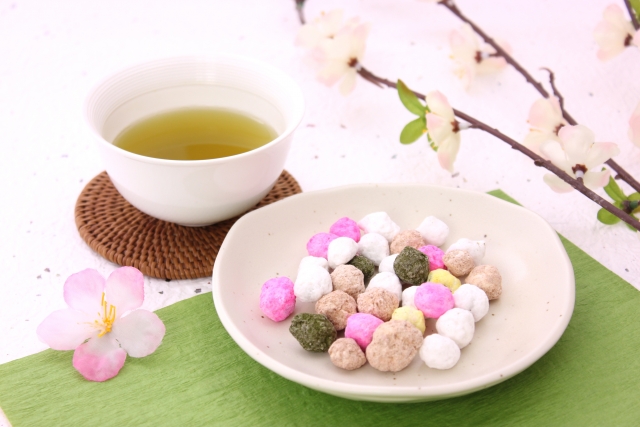
Hello, again. This is BabyJ😊.
March 3rd was “Hinamatsuri”, Doll’s Festival, or “Girl’s Day,” the day to celebrate healthy growth of a female child and pray for her happiness.
“Hinamatsuri,” is also called, “Momo-no-sekku,” the season of peach blossoms. Peach blossoms are believed to ward off evil spirits.
How We Celebrate Hinamatsuri?

A family with a female child displays “Hina-ningyo (Hina dolls)” at home and eats special sweets and foods for this occasion, such as “Hishi-mochi,” a three layered diamond-shaped rice cake, “Hina-arate,” pastel colored flake-like rice cookies, “Chirashi-zush,” sushi rice in a box or bowl topped with sashimi and other ingredients, and Japanese-style clam soup, for the celebration.
What is the origin of “Hina-ningyo (Hina dolls)

In the old times, people used to put a doll made of paper or straw into a river to ward off evil spirits.
Later this doll developed into a gorgeous doll of a court lady, and then into “Hina-ningyo (Hina dolls)” now displayed in homes on a “HIna-dan”, a layered hina stands.
Who are sitting on the Hina-dan, Hina stands?

Hina-ningyo (Hina dolls)” are placed on a layered “Hina-dan (Hina stands),” from one layer to 7 layers, depending on the wealth or preference of a family.
The couple sitting at the top layer is believed to be an emperor and an empress and their servants, musicians, staff members of the court are sitting on the layers that follow.
Also dressers, mirror stands, tables, tea sets, sewing sets, and others, which a court lady in the old times was required to bring to her groom’s place when they marry, are placed on the bottom layer.
Sweets and Foods for Hinamatsuri

The sweets and the foods that are eaten on this day have special meanings.
“Hishi-mochi,” a diamond-shaped rice cake has three layers in white, green and pink.
The three colors, White, Green and Pink, each stands for snow, a bud and peach blossoms respectively.
When combined, they stand for “spring,” in which white snow is melted, a green bud comes out and grows into pink peach blossom tree.

“Hina-arate,” are pastel colored flake -like rice cookies. They are also in the color of white, green and pink. They used to be a crushed form of “Hishi-mochi” in the old times.
Why is Clam Soup Eaten?

Also eaten on Hinamatsuri is “Chirashi-zush,” which is sushi rice in a box or bowl topped with sashimi and other ingredients, and a Japanese-style clam soup for the celebration.
But why is “clam” soup eaten on this occasion?
Eating clam soup is a wish for a female child to find a husband who is a perfect match for her, and that they would have a happy marriage thereafter.
“Clam” shell stands for “perfect match,” as any one of the upper and lower shells won’t match unless they both come from the same clam.
Traditional Beliefs Behind Hinaningyo

We put up “Hina-ningyo (Hina dolls)” in early February, about a month before Hinamatsuri in our home.
But we must put them away right after the Hinamatsuri. Otherwise, the female child of a family won’t be able to marry until old age or even won’t be able to marry at all.
This is a belief or superstition attached to Hina-ningyo (Hina dolls). A family with a female child, therefore, cannot help but follow this practice.
In Japan, it has been believed that women better marry at an early age when they are still young, fresh and beautiful.
Remaining single after a certain age is considered abnormal and or pitiful.
As individualism is now prevalent in Japan, it is now an considered old-fashioned way of thinking. But, the older generations still believed this way.
It seems like many of the Hinamatsuri tradition are attached to marriage.
To my surprise, I myself still follow this belief and put away my Hina-ningyo right after March 3rd, although I am too old to get married again.

